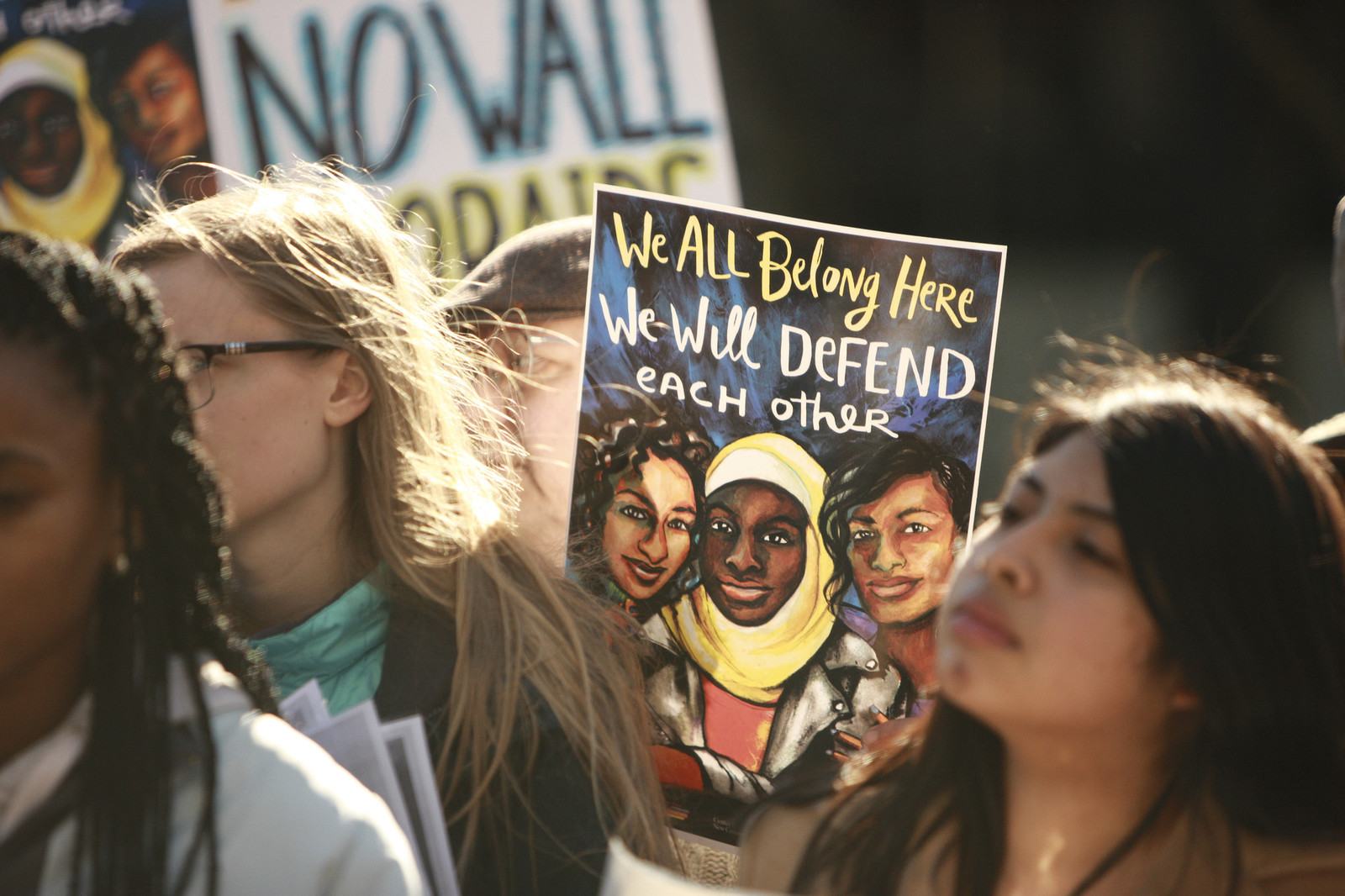
Update as of Jan. 25, 2021: Soon after taking office, President Joe Biden issued an executive order ending the Muslim ban. The move was one of several positive immigration policy changes made by the adminstration.
Learn more: "Biden's changes to the immigration system explained."
Three years after President Trump first issued his Muslim ban—an executive order banning travel from several mostly Muslim countries—its dangerous impacts continue to grow, further institutionalizing xenophobia and Islamophobia in the U.S.
At the start of 2020, the Trump administration announced it would expand the ban, which would affect six more countries in Africa and Asia, effective Feb. 21.
While the Muslim ban has gotten less attention in the media—amid other attacks on immigration as well as the impeachment proceedings—we must continue our efforts to stop this racist policy, in any form it takes.
Here’s what you need to know:
1. What’s happening with the Muslim ban now?
Although the first and second iterations of the Muslim ban were struck down by federal judges who said it amounted to religious discrimination against Muslims, the Supreme Court upheld the third version of the policy in June 2018.
The justices ruled in favor of the Trump administration on the grounds that federal law gives the President broad authority to suspend entry to the U.S.–a justification that has helped the Trump administration further camouflage the xenophobic, racist, and Islamophobic intent behind the policy.
The Court also ruled that the third version of the ban could be implemented while lower courts considered whether it was appropriate for litigation to continue. Since then, the upheld restrictions have blocked travel by people from Iran, Libya, Somalia, Syria, Yemen, and North Korea, and political officials from Venezuela.
On Jan. 28, 2020, the Fourth Circuit Court heard arguments over whether civil rights groups can proceed in challenging the Trump administration's third version of the Muslim ban based on its discriminatory intent. A decision is expected in the coming months.
And on Jan. 31, the Trump administration announced plans to expand the ban to include more countries in Africa and Asia. Under the policy, citizens from Nigeria, Eritrea, Myanmar, and Kyrgyzstan will be barred from applying for visas to immigrate to the U.S. Citizens of two other countries, Sudan and Tanzania, will no longer be allowed to participate in the Diversity Visa lottery, which diversifies the source countries of immigrants to the United States, particularly allowing individuals of African countries to migrate to the U.S. who otherwise will not be able to migrate.
The expanded ban took effect on Feb. 21.
2. Who is currently affected by the Muslim ban?
Under the ban, millions of people fleeing violence; hoping to reunite with their families, access medical treatment, pursue their careers; and many more are banned from entering the United States.
The number of refugees from Muslim majority countries seeking protection in the U.S. has declined. And the number of visas issued to nationals of Muslim majority countries – including nationals from non-banned countries has declined as well.
The Muslim ban not only impacts people attempting to enter the United States but people who are currently in the U.S. Muslim Americans residing in the U.S. have been cut off from their families and friends who are barred from entering the country. And we've also seen a rise in incidents of intimidation, bias and violence against people in Muslim-American majority communities.
Under the third version of the Muslim ban, the administration created an opportunity for people from the banned countries to still enter the country by obtaining waivers. But these waivers are only available to visa applicants who can meet certain requirements, and the waiver process has also been plagued with chaos. Denials of waiver applications are the norm, and the process is cumbersome, confusing, and as one Supreme Court Justice called it, “window dressing.”
For Iranian nationals who are also affected by economic sanctions and ongoing tensions, the impact of the ban is multiplied. One Iranian student with a valid student visa was denied entry into the U.S. by immigration officials at the airport and deported to Iran, despite a court order for an emergency stay. And in early January, dozens of Iranians—including American citizens—where detained at the U.S. border with Canada and subjected to hours of questioning.
3. The Trump administration is using the Muslim ban to further deny protection towards those from countries experiencing war, natural disasters, or humanitarian crises.
The Muslim ban has also affected people from four countries that have—or have had—Temporary Protected Status (TPS) designations: Somalia, Syria, Yemen, and Sudan. TPS offers protections from deportation to people from countries afflicted by war, natural disaster, or other humanitarian crises.
Somalia, Syria, Sudan, and Yemen have had TPS designations for years. But unlike previous administrations, the Trump administration has refused to redesignate TPS for these countries, leaving recent arrivals to the U.S. in limbo.
Sudan was one of the countries named in the second version of the Muslim Ban but was removed when the third version was issued. Instead, the administration terminated TPS for Sudan, forcing Sudanese nationals residing in the U.S. into a state of limbo and making it harder for recent arrivals to seek protection in the U.S. and in January 2020, banned Sudanese nationals from participating in the Diversity Visa program.
For people from these four countries, being denied TPS has much of the same effect of the Muslim ban itself–leaving vulnerable groups of people without protection and few options.
4. The Muslim ban is part of the Trump administration’s increased attacks on communities of color, immigrants, and Muslims.
Since taking office, Trump has worked to dramatically reduce immigration to the United States, particularly of people of color–by keeping Muslims and other people out, deporting people who are here, and creating an atmosphere of nativism and fear. In fact, the most recent expansion of the Muslim ban has led some advocates to criticize the policy as an “African ban.”
What’s more, the administration set the refugee admissions goal for this fiscal year at 18,000–the lowest level in U.S. history. This new number will extremely reduce the number of refugees coming from countries in the Middle East and Africa, exacerbating the horrific impacts of the Muslim ban.
Last fall, the administration also issued an executive order allowing state and local officials to block refugee resettlement in their communities, a decision akin to promoting racial segregation and restricting rights to freedom of movement based on one’s immigration status.
Although the policy was temporarily halted by the courts, if implemented, it could affect currently settled refugees who live in areas that apply the policy and are hoping to be reunited with their loved ones. It will also force refugees to choose between settling in areas that provide resources to resettle refugees or settling in areas closer to family and an established community.
5. Muslims, allies, advocates, and others across the country continue to challenge the ban—and we have a solution.
Communities across the country will not stop working to end the Muslim ban—and any racist ban put forward by this administration, including its attacks on the asylum system.
In addition to challenging the ban in the courts, we continue to advocate for a legislative solution. Members of Congress have acted by introducing the NO BAN Act (H.R. 2214 and S. 1123). The current bills would end the Muslim, refugee, and asylum bans by preventing future presidents from targeting people based on religion or other criteria.
All of us deserve to feel safe from hatred and to live and pray in peace.
Use our resources to help spread the message: The Muslim ban has no place in our society—not now, not ever:
